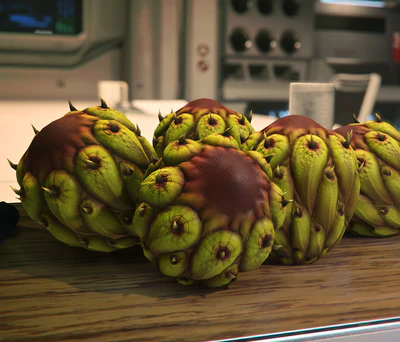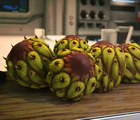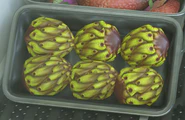 | |
| Jumping Limes | |
|---|---|
| Type | Natural |
| Occupancy | 350 mSCU |
| Base price | 5 aUEC |
| Consumable | |
| Container | Fruit |
| NDR | 9 |
| HEI | 6 |
| Uses | 1 |
| Buff | Dehydrating (10 mins) |
Jumping Lime (Yar Fruit)
The jumping lime, also called the Yar lime or the Yar fruit, is a sweet, sour, astringent fruit that grows from a cactus that naturally mutated on Yar (Centauri II) some time after the planet's terraformation. Discovered in 2450, the fruit was named for the ease with which it falls off its parent plant and clings to clothing and skin. It was domesticated as a crop plant in the early 26th Century. Wild specimens can still be found in Yar's Red Desert, but they are not as sweet as the domesticated variety.[1]
Cultivation
The jumping cactus (cylindropuntia acerbus), the plant from which the jumping lime grows, is a mutation of the Earth (Sol III)-native plant jumping cholla (cylindropuntia fulgida). A tree-like plant, it has branches that grow near the base of the trunk, each one covered in small, hair-like spines with tiny hooks on the end. It grows to heights of roughly three meters. The branches are susceptible to overgrowth during especially wet years, and will prematurely die unless pruned or supported. Rows of jumping cacti with their branches tied to stakes are a common sight in Yar's former mining towns. At the end of the wet season, a vivid purple and green flower sprouts from the end of each branch of the cactus. If a flower is pollinated by hand or by night-flying insects, the petals will wither and it will develop into a spiny, round, purplish fruit. Branches that don't produce fruit tend to drop off the plant and dry in the desert sun. After four weeks of growth, farmers remove the branches with stunted fruit to concentrate the plant's resources on the branches growing big, healthy fruit. At eight weeks, the barbed, leathery skin of the fruit turns green and is ready to be harvested. Workers traditionally wear protective gear as the spines can pierce skin. The fruit must be de-spined and peeled in order to access the sweet, very tart, astringent flesh.
Distribution
Cylindropuntia acerbus is indigenous to Yar and takes easily to any planet with deserts or dry forests. The Red Desert is home to a number of thick forests of the plant that may range over many hectares. It is common to see local fauna with the fruit attached to their hides, which is the main way the plant's seeds are spread in the wild. Some desert animals have adapted to be able to cope with the plant's spines and will break open the unripe fruit to consume it during the dry season. Although the fruit does have hydrating properties, its juice is astringent enough that it often causes a feeling of false dehydration. Yar locals warn against eating the fruit unless another source of water is nearby.
Uses
Jumping limes are appreciated for their intense flavor and aroma, though many prefer to eat them cooked rather than raw. When they are roasted, some of the astringency decreases and the sugars caramelize, transforming the flesh from very tannic and sour to bright and acidic. Yar locals will peel, chop, and stew the fruit with sweetener until it's completely broken down into pulp, and then strain it and use the liquid to make jelly. The resulting product is very sour and sweet, slightly bitter, and leaves a dry feeling in the mouth after it's consumed. While Humans who don't live on Yar largely consider the jumping lime jelly an acquired taste, it is popular among Banu for its complex flavor profile. Formerly economically depressed towns on Yar have experienced positive growth in recent years thanks to exports to the Protectorate or sales to passing Soulis.
Gallery
References

